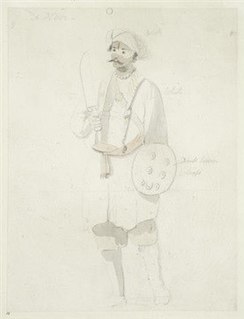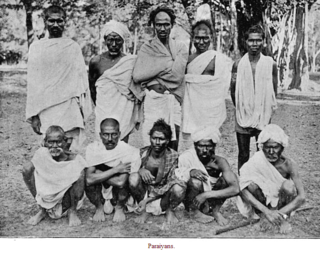Related Research Articles
The Maratha caste is composed of Marathi clans originally formed in the earlier centuries from the amalgamation of families from the peasant (Kunbi), shepherd (Dhangar), pastoral (Gavli), blacksmith (Lohar), carpenter (Sutar), Bhandari, Thakar and Koli castes in Maharashtra. Many of them took to military service in the 16th century for the Deccan sultanates or the Mughals. Later in the 17th and 18th centuries, they served in the armies of the Maratha Empire, founded by Shivaji, a Maratha by caste. Many Marathas were granted hereditary fiefs by the Sultanates, and Mughals for their service.

The Nair, also known as Nayar, are a group of Indian Hindu castes, described by anthropologist Kathleen Gough as "not a unitary group but a named category of castes". The Nair include several castes and many subdivisions, not all of whom historically bore the name 'Nair'. These people lived, and continue to live, in the area which is now the Indian state of Kerala. Their internal caste behaviours and systems are markedly different between the people in the northern and southern sections of the area, although there is not very much reliable information on those inhabiting the north.
Kārkāthār is a Hindu caste in the Indian state of Tamil Nadu.

Kurmi is traditionally a non-elite tiller caste in the lower Gangetic plain of India, especially southern regions of Awadh, eastern Uttar Pradesh and parts of Bihar. The Kurmis came to be known for their exceptional work ethic, superior tillage and manuring, and gender-neutral culture, bringing praise from Mughal and British administrators alike.
Vokkaliga is a community, or a group of closely-related castes, from the Indian state of Karnataka. They are also present in the neighbouring state of Tamil Nadu.
Vellalar is a generic Tamil term used primarily to refer to various castes who traditionally pursued agriculture as a profession in the Indian states of Tamil Nadu, Kerala and northeastern parts of Sri Lanka. The Vellalar are members of several endogamous castes such as the numerically strong Arunattu Vellalar, Chozhia Vellalar, Karkarthar Vellalar, Kongu Vellalar, Thuluva Vellalar and Sri Lankan Vellalar.

Paraiyar, or Parayar or Maraiyar, is a caste group found in the Indian states of Tamil Nadu and Kerala, and Sri Lanka.
Kongu Vellalar is a community found in the Kongu region of Tamil Nadu, India.
Balija is a caste of the Indian states of Andhra Pradesh, Tamil Nadu, Karnataka, and Kerala.

The Vanniyar, also spelled Vanniya, formerly known as the Palli, are a Dravidian community or jāti found in the northern part of the Indian state of Tamil Nadu. From the 19th century, peasant castes typically classified under Shudra category, such as Vanniyars have made mythical claims that their ancestor was born from the flames of a fire sacrifice. Certain Merchant and Artisan castes have fire born myths as well. Many Lower castes use a process of Sanskritisation to get upward mobility by creating such fire myths. Vanniyars, historically considered a lower caste, have been trying to gain upward mobility since 19th century to move away from lower status using these Agnikula myths.
Sri Lankan Vellalar is a caste in Sri Lanka, predominantly found in the Jaffna peninsula and adjacent Vanni region, who comprise about half of the Sri Lankan Tamil population. They were traditionally involved in agriculture, but also included merchants, landowners and temple patrons. They also form part of the Sri Lankan Tamil diaspora.
The Western Ganga Dynasty ruled large parts of southern Karnataka from the fourth century CE till the late tenth century CE with their regal capital initially at Kolar and later at Talakad in Mysore district, Karnataka. The origin of the Ganga clan prior to the fourth century is shrouded in legends and myths. Clarity into their history comes from such contemporaneous writings as Chavundaraya Purana in Kannada and Lokhavibhaga in Prakrit and from numerous inscriptions excavated in the Mysore, Bangalore and Kolar districts and Anantapur district. The Western Gangas played a pivotal role in the development of polity, culture and literature during their long rule in the region, at times as independent monarchs and at other times as subordinates of their larger neighbors: the Badami Chalukyas and later the Rashtrakutas of Manyakheta. Their patronage to literature in Kannada and Sanskrit, their achievements in architecture including the famous monolith of Gomateshwara, their Hindu temples in the southern Karnataka, and their Jain Basadi's of Shravanabelagola and Kambadahalli are testimony to the rich contribution they made to the region.
Thuluva Vellalar, also known as Agamudaya Mudaliars and Arcot Mudaliars, is a caste found in northern Tamil Nadu, southern Andhra Pradesh and southern Karnataka, India. They were originally significant landowners.

Kallar is one of the three related castes of southern India which constitute the Mukkulathor confederacy. The Kallar, along with the Maravar and Agamudayar, constitute a united social caste on the basis of parallel professions, though their locations and heritages are wholly separate from one another.

Kiryathil Nair or Kiriyath Nair is a martial nobility caste belonging to the Kshatriya varṇa, which forms one of the highest-ranking subcastes of the Nair community along with the Samantha Kshatriyas with whom they share a close history. They constituted the ruling elites (Naduvazhi) and feudal aristocrats (Jenmimar) in the regions of Malabar and Cochin in present-day Kerala, India. As the pinnacle of the Nair hierarchy, the Samanthan and Kiryathil Nairs were second only to the Namboodiri Brahmins in social status, and outranked even the priestly Ambalavasis.

The Kunchitigas are a community of people from Karnataka, India. They are mostly concentrated in the Tumkur, Bangalore, Mysore, Ramanagara and Chitradurga districts. They are also found in Tamil Nadu.
Gowda is a surname native to the Karnataka state of India. It is mainly found among the Vokkaligas in south Karnataka and the Lingayats in north Karnataka. It is also used by Kurubas.
The Jat people are a traditionally agricultural community in Northern India and Pakistan. Originally pastoralists in the lower Indus river-valley of Sindh, Jats migrated north into the Punjab region in late medieval times, and subsequently into the Delhi Territory, northeastern Rajputana, and the western Gangetic Plain in the 17th and 18th centuries. Of Muslim, Sikh, and Hindu faiths, they are now found mostly in the Pakistani provinces of Sindh and Punjab and the Indian states of Punjab, Haryana, Uttar Pradesh and Rajasthan.
Madapalli is a caste found mainly in the northern part of Sri Lanka. Found today as a subcaste of the Sri Lankan Vellalar, the Madapallis were considered an independent caste until recently.
Kondaikatti Velaalar is a Tamil caste who traditionally pursued agriculture as a profession in the Indian states of Tamil Nadu, Kerala and northeastern parts of Sri Lanka. They were originally settled in Tondaimandalam but spread to other areas in south India over time. Since they historically used the Mudaliar title, they are sometimes referred to as Thondaimandala Vellala Mudaliars or simply Thondaimandala Mudali. However, Kathleen Gough considers them to be a separate subcaste of the Thondaimandala Mudali, as does Susan Neild.
References
Notes
- ↑ Susan Bayly has noted of the Vellalar communities generally that "they were never a tighly-knit community ... In the eighteenth and early nineteenth centuries Vellala affiliation was a vague and uncertain as that of most other south Indian caste groups. Vellala identity was certainly thought of as a source of prestige, but for that very reason there were any number of groups who sought to claim Vellala status for themselves". [3]
Citations
- ↑ Gough (1982), p. 19
- ↑ Neild (1979)
- ↑ Bayly (2004), p. 411
- ↑ Gough (1982), p. 25
- ↑ Stein, Burton (1980). Peasant State and Society in Medieval South India. Delhi: Oxford University Press. p. 319. ISBN 978-0-19-563507-2.:”The Gangadikara peasantry of Gangavadi appears to have been more significantly linked to the Kongu peasantry to the south than to peasant peoples in the central and northern parts of medieval Karnataka. Similarly, the Marasu Vokkaligas of eastern Bangalore and central and southern Kolar districts appear to have been linked to Tondaimandalam”
- ↑ Gough (1982), pp. vii, 358
Bibliography
- Bayly, Susan (2004) [1989]. Saints, Goddesses and Kings: Muslims and Christians in South Indian Society, 1700-1900. Cambridge University Press. ISBN 978-0-52189-103-5.
- Gough, Kathleen (1982). Rural Society in South East Asia. Cambridge University Press. ISBN 978-0-52104-019-8.
- Neild, Susan M. (1979). "Colonial Urbanism: The Development of Madras City in the Eighteenth and Nineteenth Centuries". Modern Asian Studies. 13 (2): 217–246. doi:10.1017/S0026749X00008301. JSTOR 312124.